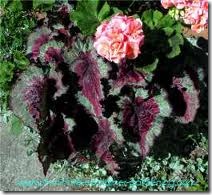Mold disease in begonias has many possible causes, nut usually they are either related to pests or how you are caring for the plant. Pests can be exposed to your plant by other diseased plants, or if they are aphids, moths, fungus gnats or whiteflies, they can fly to your plant and infest.
Care
-
Use caution when applying pesticides.
Mold can develop at the roots of the begonia when there is not proper drainage for the soil. Also, over-watering can contribute to or even cause an issue with mold around the leaves at the base of the plant and on the dirt. The soil needs to stay damp without being overly wet. You may even let the soil dry out between watering to ensure there is no development of mold.
Honeydew or Sooty Mold
-
Household pests like mealybugs, aphids, scale or ants can begin feeding on your rex begonias and leave behind a honeydew-like substance. Untreated, honeydew will cause an unattractive black fungal surface growth to begin covering the leaves and other surfaces of your plants. Take care of the pests by using an insecticide or cultivating other insects or plants that are natural enemies. Use a damp cloth to gently wipe the leaves or use a gentle sprayer.
Powdery Mildew
-
 Aphids can cause honeydew or sooty mold.
Aphids can cause honeydew or sooty mold.Powdery mildew is a fungus that is usually found on household plants that lack adequate circulation or light. If you live in an area where nights are cool and days are warm and humid, your begonias may be more prone to this. This powdery white or gray fungus can usually be found on the upper surfaces of leaves. They will begin to turn yellow or brown and fall off. The new growth will be distorted. To treat this disease, be sure your plant has adequate light and air circulation. You may need to move them outside if weather permits. Do not get the leaves wet when watering. Treat with a fungicide as soon as you notice any signs of disease and thoroughly clean up any debris or dead leaves and flowers.
Stem Rot
-
Stem rot, or brown rot, is caused by Botrytis blight. Brown, moist spots form on the flowers, leaves or stems. The begonia appears to be wilted but does not improve with watering. The begonia will develop a fuzzy, gray mold as the disease progresses. Eventually, the roots will collapse and the plant will die. Treat with a fungicide and remove any affected parts.
Precautions
-
Because plant conditions vary, test your plant for the effects of a pesticide. Use pesticides recommended for your climate and region. Test on a few small plants before using on all of your plants to ensure there will be no damage.


Deprecated: strpos(): Passing null to parameter #1 ($haystack) of type string is deprecated in /home/agriviek8Qv/agriviet.net/public_html/wp-includes/comment-template.php on line 2522